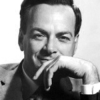Richard P. Feynman

Richard P. Feynman
Richard Phillips Feynmanwas an American theoretical physicist known for his work in the path integral formulation of quantum mechanics, the theory of quantum electrodynamics, and the physics of the superfluidity of supercooled liquid helium, as well as in particle physics for which he proposed the parton model. For his contributions to the development of quantum electrodynamics, Feynman, jointly with Julian Schwinger and Sin-Itiro Tomonaga, received the Nobel Prize in Physics in 1965...
NationalityAmerican
ProfessionPhysicist
Date of Birth11 May 1918
CountryUnited States of America
Richard P. Feynman quotes about
The present situation in physics is as if we know chess, but we don't know one or two rules.
All theoretical chemistry is really physics; and all theoretical chemists know it.
One of the ways of stopping science would be only to do experiments in the region where you know the law. But experimenters search most diligently, and with the greatest effort, in exactly those places where it seems most likely that we can prove our theories wrong. In other words, we are trying to prove ourselves wrong as quickly as possible, because only in that way can we find progress.
The principle of science, the definition, almost, is the following: The test of all knowledge is experiment. Experiment is the sole judge of scientific "truth." But what is the source of knowledge? Where do the laws that are to be tested come from? Experiment, itself, helps to produce these laws, in the sense that it gives us hints. But also needed is imagination to create from these hints the great generalizations--to guess at the wonderful, simple, but very strange patterns beneath them all, and then to experiment to check again whether we have made the right guess.
We need to teach how doubt is not to be feared but welcomed. It's OK to say, "I don't know."
What is the fundamental hypothesis of science, the fundamental philosophy? We stated it in the first chapter: the sole test of the validity of any idea is experiment. ... If we are told that the same experiment will always produce the same result, that is all very well, but if when we try it, it does not, then it does not. We just have to take what we see, and then formulate all the rest of our ideas in terms of our actual experience.
When the problem [quantum chromodynamics] is finally solved, it will all be by imagination. Then there will be some big thing about the great way it was done. But it's simple -it will all be by imagination, and persistence.
Precise language is not the problem. Clear language is the problem.
If you have any talent, or any occupation that delights you, do it, and do it to the hilt. Don't ask why, or what difficulties you may get into.
Know how to solve every problem that has been solved.
Some things that satisfy the rules of algebra can be interesting to mathematicians even though they don't always represent a real situation.
Thus we can get the correct answer for the probability of partial reflection by imagining (falsely) that all reflection comes from only the front and back surfaces. In this intuitively easy analysis, the 'front surface' and 'back surface' arrows are mathematical constructions that give us the right answer, whereas .... a more accurate representation of what is really going on: partial reflection is the scattering of light by electrons inside the glass.
There's plenty of room at the bottom.
Ordinarily it would take me about fifteen minutes to get a hallucination going," wrote Feynman, "but on a few occasions, when I smoked some marijuana beforehand, it came very quickly.